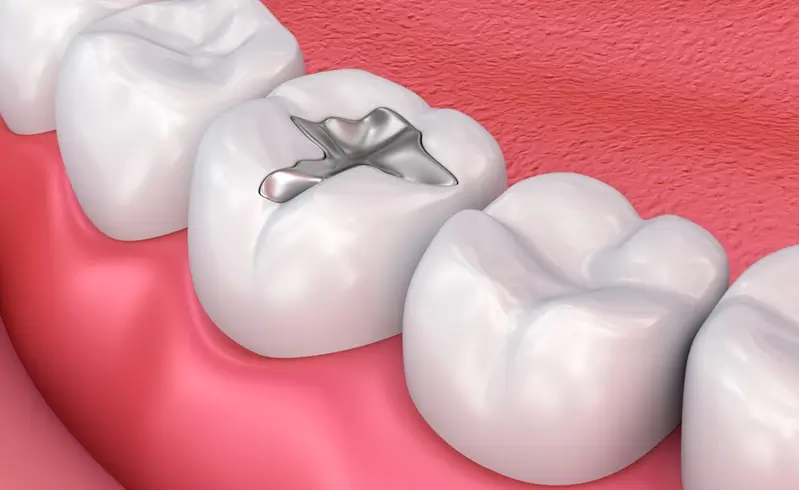Dental fillings are long-lasting, but sadly won't last forever. How frequently a filling needs replacing depends on the level of wear and tear – as affected by the material used, the types of foods consumed or problems with tooth grinding.
Types of dental filling
There are several restorative materials used for dental fillings and which option is chosen can impact their longevity.
1) Dental amalgam
Dental amalgam is often used to treat large cavities.
Also known as silver or metal amalgam fillings, this option involves an alloy of two of more materials including silver, tin, copper and mercury. Dental amalgam is often used to treat large cavities on the back teeth for cosmetic reasons and because it is a relatively cheap option. It's also especially durable, making it ideal for the teeth that do much of the work involved in chewing food.
Amalgam hardens quickly, making it a quick treatment and helpful for areas such as below the gumline, which are difficult to keep dry. One drawback is that amalgam fillings may require the removal of healthy sections of tooth to make a space large enough to support the material.
Despite previous concerns about the safety of dental amalgam, the New Zealand Dental Association and World Health Organisation have found the fillings safe and reliable.
2) Composite resin
Composite fillings are made from plastic and one of their advantages is that they are tooth-coloured and therefore cosmetically pleasing. Working by sticking to the tooth, composite resin fillings are installed gradually until the cavity is restored. The resin is hardened by a blue light treatment and the patient can eat and drink normally immediately following the treatment.
The same material may be used to treat chips or cracks to a tooth.
3) Porcelain or gold
Fillings made of either porcelain or gold are as hard wearing as amalgam but can also be as expensive. Some patients prefer the colour to that of silver amalgam and there is less risk of tooth discolouration. Gold fillings require at least two visits to the dental practice.
4) Inlays and onlays
Inlays and onlays are an alternative when a standard filling is not sufficient but a full dental crown is not necessary. Inlays fill areas within the chewing surface of the tooth only. Meanwhile, onlays cover the entire surface and extend slightly below.
In general, inlays and onlays are a form of indirect filling, which means they are custom-made in a dental laboratory and bonded to the tooth on a second visit. They may more rarely be used as a direct filling, placed in one visit straight to the cavity. Inlays and onlays are preferable to the dental crown in some cases because it is not necessary to remove large parts of the tooth's original structure.

When a dental filling needs replacing
Should a filling become loose, cracked, fall out or worn, it's time for a replacement. A damaged filling provides a gateway for bacteria and food particles to enter the tooth and cause problems such as tooth decay. Identifying the need to replace a filling early can prevent costly procedures, such as a root canal to remove infected dental pulp.
It's hard to keep an eye on your own dental fillings, so regular dental checkups are essential to prevent issues from developing. Dentists check for cracks or other problems with fillings by probing the edges with a tool known as a dental explorer. They'll look for any worn away or cracked sections that could signal the need for a replacement. A dentist may also use x-rays to check for signs of decay inside the tooth or under the gums that aren't visible to the naked eye.
Should you have any concerns about your existing fillings, or think you may need dental treatment, call City Dentists on 04 978 4964 or book an appointment online.
